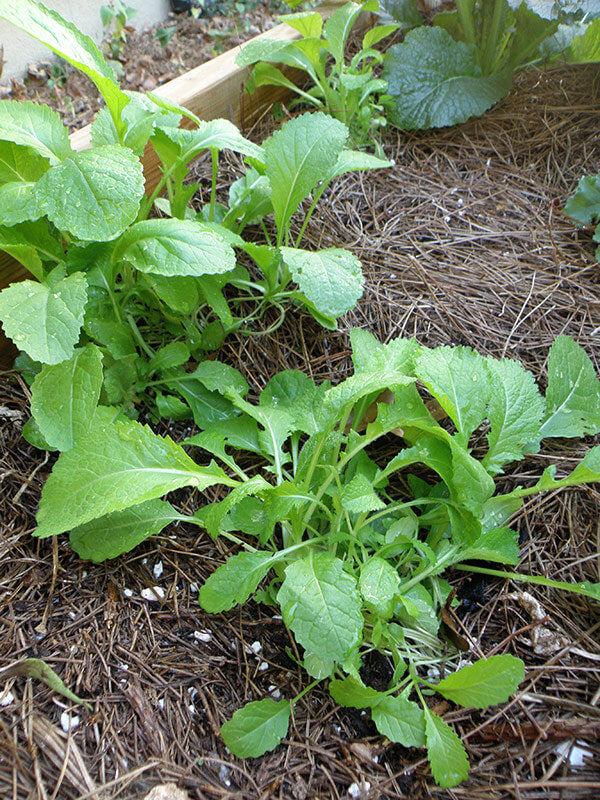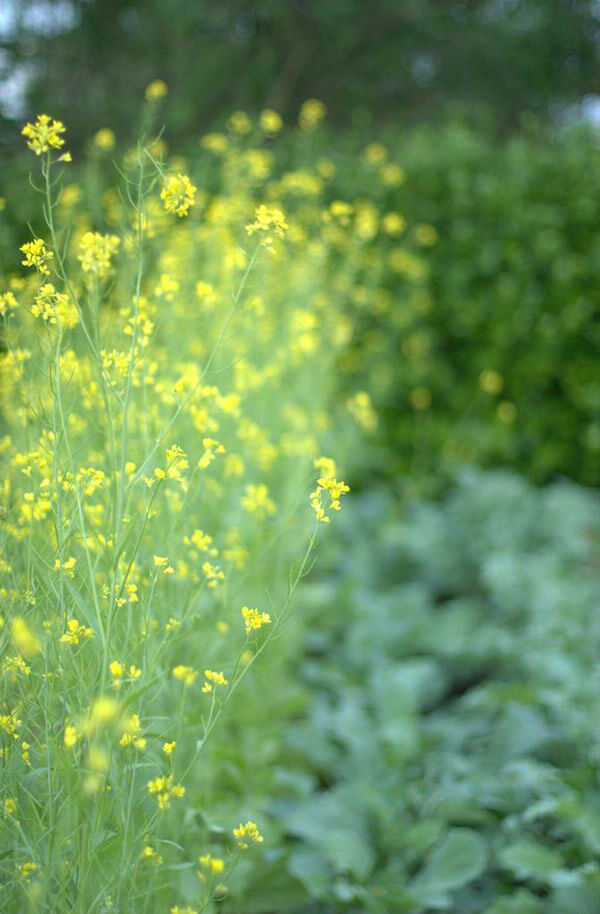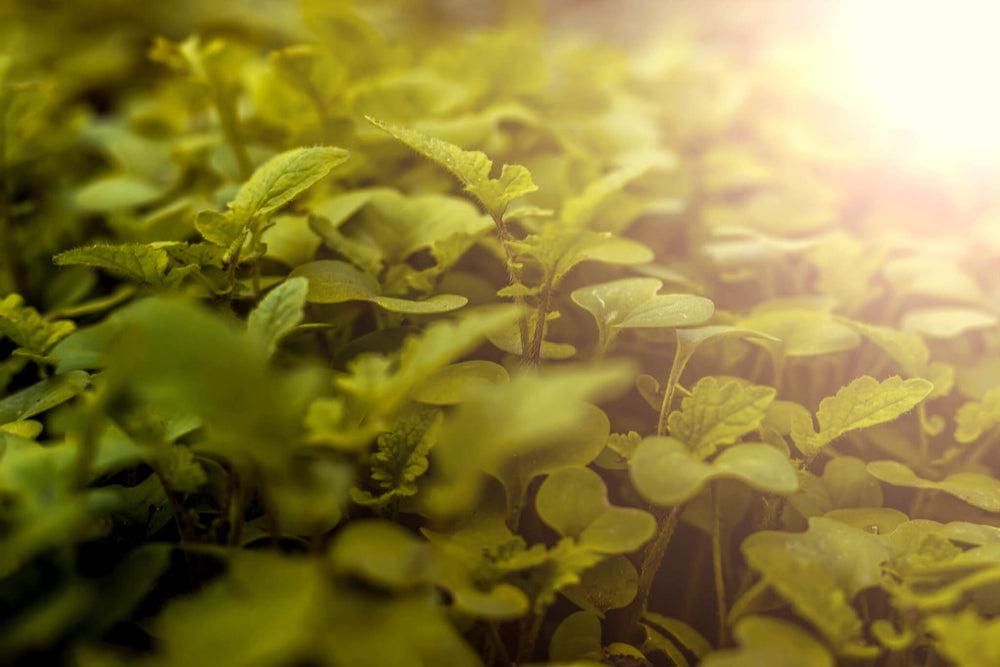Mustard greens are fast growing, nutritious leafy greens. They're perfect for gardens and containers in both spring and fall. Although not quite as cold hardy as their cousins, collards and kale, piquant mustard greens do tolerate a light frost, which makes their leaves sweeter. In areas where there are no killing freezes, gardeners enjoy growing mustard greens all winter long. The mustard patch is a pretty sight in the cool season garden. The leafy plants are easy to care for and good companions to fall flowers such as pansies. Mustard greens grow in a rosette of leaves up to about a foot-and-a-half tall. You can simmer the big peppery greens or pick smaller, young leaves to eat raw in salads and sandwiches.
Quick Guide to Growing Mustard Greens
- Plant mustard greens during the cool temperatures of spring and fall. These tasty greens grow well in raised beds, containers, and in-ground gardens.
- Space plants 12 to 18 inches apart in an area that gets plenty of sunlight and has fertile, well-drained soil with a pH of 6.5 to 6.8.
- Improve native soil by mixing in several inches of aged compost or other rich organic matter.
- Mustard greens can produce edible leaves quickly with a steady supply of water. Check soil moisture regularly and water when the top inch of soil becomes dry.
- After planting, encourage excellent leaf production by regularly feeding plants with a water-soluble plant food.
- Harvest mustard greens when leaves are large enough to eat.
Soil, Planting, and Care
Mustard leaves grow fast and most tender in moist, rich soil. Sun is ideal, but because they make only leaves and not fruit, they are a little more tolerant of shade than fruiting vegetables like tomatoes. Enrich the texture and nutrition of the planting area by mixing in three inches of compost or Miracle-Gro® Performance Organics® All Purpose In-Ground Soil with the top six inches of existing soil. (A digging fork works well for this.) For pots, use a premium quality potting mix like Miracle-Gro® Performance Organics® All Purpose Container Mix to help you get a big harvest. It always seems early when it's time to plant mustard, but it pays to plan ahead. For fall harvests, set plants in the garden 4 to 6 weeks before the first expected frost. In spring, you can start about 4 weeks ahead of the last frost date and continue planting a little after.
If you're looking for an impressive harvest down the road, skip the seeds and plant strong, vigorous Bonnie Plants® mustard greens instead. Our plants come thickly seeded in their pots. You may set them out as they are, but they will grow faster and give you more if you take a little time to separate the seedlings. Gently tease the seedlings apart into 3 to 6 clumps. Be careful not to tear up the roots. If they don't tease apart gently, you can cut the clump in half with a knife and in half again. Space clumps 12 inches apart for traditional mustard greens, 12 to 18 inches apart for Japanese Giant Red Mustard (a slightly larger plant).
Mulch with wheat straw to keep plants moist. It takes about 10 to 12 plants to supply two people with fresh greens plus extra to freeze and use during warmer weather.
Mustard grows fast, so you can begin picking leaves in about 4 weeks, when the leaves are 6 to 8 inches long. Left alone, leaves reach their full size of 15 to 18 inches long in about 6 weeks. To maintain the rapid leafy growth and maximize your harvest, there's one more thing you can do in addition to planting Bonnie Plants® in rich soil: Give your mustard plants regular doses of just the right nutrition. Feed with a water-soluble fertilizer Miracle-Gro® Performance Organics® Edibles Plant Nutrition every seven days.
If your family enjoys mustard greens, consider planting every 2 to 3 weeks for successive waves of young flavorful greens growing into prime size.
Remember, optimum growth and flavor depends on moist soil. When plants grow under stressful conditions such as drought or heat, the leaves can become unpleasantly spicy for most tastes. Keep the soil evenly moist.
Troubleshooting
Although mustard greens don't have many problems, you will need to protect them from cabbage loopers and imported cabbageworms. Flea beetles can also feed on leaves. Floating row covers are a great way to protect the greens without pesticides, or you can spray them with product containing "Bt" (Bacillus thuringiensis), for the caterpillars, or insecticidal soap or a pyrethrin-based spray for the beetles. Clubroot is a disease that plagues mustard and other members of the cabbage family. Have your soil tested and apply the lime necessary to maintain a soil pH of 6.5 to 6.8 to discourage clubroot. Also, change the layout of your garden each season so members of the cabbage family don't grow in an area but once every 3 years.
Harvest and Storage
There are two ways to harvest greens. You may pick only the large, outer leaves leaving the center to continue growing and producing more greens. Or you can treat the plant in a cut-and-come again fashion, cutting all the leaves to 3 to 4 inches from the ground and leaving the stub to re-grow. Remember, young leaves have a milder flavor for salads. Mustard greens tolerate frosts and brief temperature dips into the 20's, but succumb to hard freezes. Like other greens, cold sweetens their flavor.



FAQs
How much water do mustard greens need? Are they drought tolerant?
Mustard greens need a steady supply of water — if it's not raining enough, water at the first sign of wilt. If watering, apply an inch of water in one watering to encourage deep rooting. More frequent, light watering encourages roots to stay near the soil surface, which makes plants susceptible to drought.
I was weeding yesterday, and today the mustard greens are wilted, even though the soil is moist. What is going on?
Many leafy vegetables - and mustard is one of them - have shallow root systems. As you weeded, if you chopped into soil deeply with a hoe, you might have sliced some mustard roots. Mulch around wilting plants with an organic material (straw, pine needles, chopped leaves, grass clippings) to conserve soil moisture and help protect undamaged roots. Harvest larger, outer leaves from plants that are wilting. This will give existing roots fewer leaves to support. Keep the soil moist, and plants should recover. In the future, hand-pull weeds around greens or go after them when they're young and tender, so that a gentle scuffle of the hoe removes them.
My mustard greens have started to flower. Can I keep picking leaves?
Mustard is a cool-season vegetable. That means it will naturally start producing flowers when summer's long, warm days arrive. If you spot flower stalks, you can taste a leaf and see what you think. You may find the flavor too strong and the texture tough. When plants start to flower, it's time to pull and compost the crop.
Green worms are eating the edges of my mustard greens. Can I spray anything that will kill the worms without hurting my family or pets?
Cabbageworm likes to eat mustard greens. If you've noticed a white moth fluttering among the greens, that's the source of your worms. Spray mustard greens with Bacillus thuringiensis (Bt) to control the worms. Bt doesn't affect humans or wildlife; you can harvest leaves immediately after spraying. Bt targets worms, which die after ingesting it. After you spray Bt, worms may take a few bites from the leaves, but they'll soon stop feeding and die.
My mustard leaves have squiggly, brownish to transparent lines in them that twist and turn all over the leaf. What is doing this?
Leaf miners are munching their way across your mustard greens. They're difficult to control because they actually eat inside the leaves, instead of staying on the surface. The best control is to remove affected leaves or the parts of leaves that are affected. Destroy these leaves - don't compost them.
When should I harvest mustard greens? How do I pick them?
You'll savor the best flavor when you pick leaves that are young and tender. To harvest, you can cut the entire plant, which is what commercial growers do, or pick just a few leaves. If you're not cutting the whole plant, pick individual leaves, starting from the outside of a plant. Outer leaves are larger and more mature. By picking these and allowing inner leaves to remain, you're assured of a continued harvest over time. Toss wilted or yellow leaves on the compost pile.
I picked mustard greens last week and the patch still looks sparse. Is there anything I can do to jump-start growth?
Give your plants a boost by applying fish emulsion or a conventional liquid fertilizer such as 20-20-20 at the rate recommended on the label. Applying one of these fast-acting liquid fertilizers after picking will help plants push out a few new leaves.





 Herbs
Herbs
 Vegetables
Vegetables
 Fruit
Fruit
 Flowers
Flowers
 Succulents
Succulents

